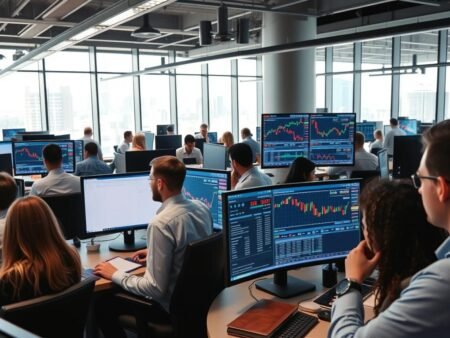In the fast-paced world of prop trading, a big question hangs in the air. Can the charm of proprietary trading firms really beat the Prop Firm Challenges for aspiring traders? Many wonder if the big profits and exciting trading scenes make it all worth it: Are Prop Firms Worth It?
This question is at the heart of our dive into proprietary trading. We’ll look at the gap between what’s promised and what really happens. It’s key to figure out if the risks of prop trading are worth the chance for big earnings and a lasting career. Let’s uncover the truth behind these firms and face the facts about their operations and results.
Key Takeaways
- Analyzing the potential and pitfall balance within the prop trading sector.
- Assessing the true value proposition of proprietary trading firms for traders.
- Investigating whether Prop Firm Challenges are a barrier to or a catalyst for success.
- Providing insights into the sustainability and profitability of a career in prop trading.
- Deconstructing the promises versus the practicalities of the prop trading industry.
- Evaluating the credibility of Are Prop Firms Worth It debate.
Understanding the Prop Trading Industry
The Prop Trading Firms world is different from regular financial brokerages. They use their own money to trade in various financial products. This is unlike brokerages that trade for their clients. Prop trading offers more flexibility but also comes with unique Prop Trading Risks.
Prop trading firms are known for their bold risk-reward strategies. These strategies can lead to big profits but also big losses. Knowing how these firms manage risk is key for anyone thinking about trading here.
- Direct access to significant market liquidity.
- Capability to leverage advanced trading technologies and software.
- Potential for rapid financial growth based on performance.
The big wins come with big risks, tied to how the firms operate and the market. Traders must understand these risks and the laws that govern the industry.
- High financial risk due to leveraged positions.
- Volatile earnings that depend heavily on market conditions.
- Regulatory scrutiny and compliance obligations.
The table below shows how prop trading firms differ from traditional brokerages:
| Feature | Prop Trading Firms | Traditional Brokerages |
|---|---|---|
| Capital Usage | Firm’s own capital | Client’s capital |
| Risk Exposure | High | Low |
| Profit Model | Based on trade performance | Commission on transactions |
| Regulatory Environment | Stringent | Regulated but less strict |
Grasping these basics helps decide if prop trading fits your financial goals and risk level. It’s also vital to see how these factors shape the financial world and the trading industry’s growth.
The Draw of a Day Trading Firm: High Hopes and Big Promises
Day trading firms are known for their fast-paced approach to the financial markets. They offer the chance to make a lot of money without needing a lot of money upfront. This is especially appealing to new traders who don’t have a lot of capital.
These firms are attractive because they provide traders with the money to trade in big volumes. This is something most traders can’t do on their own. They are often called prop trading companies.
Why Traders Flock to Prop Firms
Traders like day trading firms because they can trade without using their own money. This reduces their risk and lets them learn from experienced traders. They also get to try out different markets and instruments.
Analyzing the Profit Sharing Model
It’s important to understand how prop trading companies share profits. Traders get a part of the profits from their trades. Here’s how it usually works:
| Firm Type | Profit Share to Trader | Initial Deposit Requirement | Risk Management Rules |
|---|---|---|---|
| Standard Prop Firm | 50%-70% | Varies | Strict |
| Advanced Prop Firm | 70%-90% | Higher | Flexible |
| Beginner-Focused Firm | 40%-60% | None or Low | Very Strict |
The table shows the profit-sharing rates for different prop trading companies. This part of profit sharing affects how much a trader makes. It also influences their risk-taking behavior. Firms that offer more profit often have higher standards to meet.
In the end, day trading firms promise a lot. They offer the chance to make a lot of money and grow as a trader.
Prop Trading Firm Reviews: The Good, the Bad, and the Ugly
Entering the world of proprietary trading can be exciting but also risky. Prop Trading Firm Reviews offer a guide for those new to the field. They mix praise for innovation with criticism of firm practices, giving a clear view of the prop trading world.
Traders and experts share their stories, highlighting both wins and losses. Their detailed accounts help new traders find firms with great training and avoid those with bad ethics. We look at various Prop Trading Firm Reviews to understand why opinions vary so much.
| Firm Name | Positive Highlights | Negative Feedback |
|---|---|---|
| Global Traders Inc. | Comprehensive training, supportive community | Limited profit-sharing model |
| Equity Experts LLC | Access to advanced trading tools | High initial fees |
| Market Mavens | Flexible trading hours | Lack of transparency in operations |
| Alpha Trading Group | Encouraging trader development | Pressure to meet high performance targets |
Understanding Prop Trading Firm Reviews helps traders make better choices. Whether it’s the latest technology or community support, these insights are key to picking the right firm.
Evaluating the Worth of Prop Trading Firms
More people are interested in the Prop Trading Industry. They wonder, “Are Prop Firms Worth It?” This section looks at the money side of prop trading firms. It talks about making money, staying in business, and the ups and downs in the field.
Comparing Profitability and Sustainability
How long a prop trading firm lasts and its financial health can be checked. We look at how much money it makes and keeps over time. We also see if it can change with the market.
| Financial Metric | Average Performance | Industry Benchmark |
|---|---|---|
| Return on Investment (ROI) | 15% | 10% |
| Year-over-Year Growth | 8% | 5% |
| Profit Margin | 20% | 15% |
Success Stories vs. Hard Truths
The Prop Trading Industry has many success stories. But, these stories often hide the real challenges traders face. It’s important to know the truth behind these tales.

“For every trader who makes it big, there are many others who may not see the same level of success. It’s crucial to approach prop trading with a realistic expectation and a clear strategy.”
Knowing both the good and bad sides helps. It gives a fair view of whether Prop Firms are worth it.
Common Misconceptions About Prop Trading Companies
Prop trading offers great chances for making money, but some myths confuse new traders. These myths affect how they plan and act. Knowing the truth can help them make better choices.
Many think prop trading firms risk a lot of money. But, these firms have ways to manage risks. They don’t take big risks without safety nets, unlike what some believe.
Another myth is that traders in prop firms can do anything they want. But, firms watch closely and set limits. This is to protect both the trader and the firm’s money.
Also, some think making money is easy in prop trading. But, it’s not that simple. It takes skill, patience, and always improving your strategy.
| Misconception | Reality |
|---|---|
| High risk of catastrophic losses | Advanced risk management systems in place |
| Complete freedom in trading | Structured oversight and clear guidelines |
| Guaranteed easy profits | Requires expertise and persistence |
Clearing up these myths helps new traders understand prop trading better. It prepares them for a successful career in this field.
Prop Firm Challenges: Are They Really Worth It?
Traders entering the world of Prop Trading Firms face tough Prop Firm Challenges. These challenges test their resolve, strategy, and financial stamina. This section explores if these challenges are worth the risks and rewards of prop trading. It offers insights for both new and experienced traders to make informed decisions.
Knowing the common obstacles in this field is key for those thinking about it. Prop Forex trading can be very rewarding but comes with big Prop Trading Risks. These risks include high financial leverage, the need to meet performance targets, and the uncertainty of market volatility.
- Financial Commitment: Starting in many prop trading firms requires a big financial deposit. This is both a commitment and a risk.
- Market Dependence: The success of trades in prop firms depends a lot on market conditions. These can be unpredictable and volatile.
- Regulatory Compliance: The rules for these firms are strict. They can affect trading strategies and profits.
To better understand prop trading dynamics, here’s a table comparing challenges in prop firms with independent trading:
| Aspect | Prop Trading Firms | Independent Trading |
|---|---|---|
| Financial Risk | High (leveraged trading) | Varies (personal capital used) |
| Support Systems | Advanced (software, analysts) | Limited (self-managed resources) |
| Profit Sharing | Yes (significant portion to firm) | No (full retention) |
| Regulatory Scrutiny | High | Moderate |
| Operational Freedom | Limited (firm guidelines) | High (personal discretion) |
This table highlights the differences between trading in a prop firm and trading on your own. Prop Trading Risks are not just a warning but a key factor to think about. Each trader must weigh their ability to handle these risks against the potential financial gains of prop trading firms.
Insider Insights: What Prop Trading Professionals Won’t Tell You
The prop trading world is full of secrets that can change a trader’s life. We’ll look at some hidden facts and costs of prop firms. We’ll also share the real day-to-day life that’s not often talked about.
Hidden Fees and Costs in Prop Firms
In the world of prop trading, hidden fees can cut into a trader’s profits. These fees include desk costs, software licenses, and transaction fees. It’s important to know about these costs before starting a career in this field.
Realities of Day-to-Day Trading at a Prop Firm
Day trading firms often talk about big earnings and cool tools. But the truth is different. Traders face high pressure, strict goals, and the risk of big losses. These facts are often left out of the ads.
| Aspect | Often Advertised | Reality at Most Prop Firms |
|---|---|---|
| Earning Potential | High profits advertised | Subject to market risks and hidden fees |
| Support | Comprehensive support claimed | Can vary widely, often minimal |
| Technology | State-of-the-art tools | Access may depend on performance metrics |
| Costs | Low upfront costs highlighted | Multiple hidden fees and charges |
The Risks of Joining a Prop Trading Firm
Looking into the challenges of prop trading is key for those thinking about it. The biggest Prop Trading Risks include financial loss due to high leverage. This is because traders use a lot of leverage to try and make more money. Also, the mental stress is high, caused by market pressure and the need to always perform well.

Another big risk is the need to always beat market standards. This can lead to risky trading strategies. Also, not all trading environments have enough liquidity. This can make it hard to get out of positions, leading to bigger losses.
- Financial losses magnified by leverage
- Psychological pressure from high expectations
- Liquidity issues that may impact trading efficiency
Before joining a prop trading firm, traders need to do their homework. Knowing all the Prop Trading Risks helps prepare them for the challenges. It also helps them make smart choices that fit their trading goals and how much risk they can handle.
Advantages of Prop Trading: When It Works Well
Prop Trading Firms have many benefits that attract traders. They offer a lot of capital and learning environments. These are key to many traders’ success stories.
Access to Capital and Resources
Prop Trading Firms give traders a lot of capital. This is more than what personal accounts can offer. It lets traders take bigger positions without the costs.
These firms also provide the latest technologies and support. This helps traders analyze and execute trades quickly. It’s important for keeping up with fast market changes.
Mentorship and Learning Opportunities
Prop Trading Firms help traders grow fast. They offer mentorship and training programs. New traders learn from experienced traders.
There’s also a push for continuous learning. Traders get to attend workshops and seminars. This creates a culture of growth and improvement.
The table below shows how different Prop Trading Firms support learning and resources. It highlights how these support a trader’s success.
| Feature | Firm A | Firm B | Firm C |
|---|---|---|---|
| Initial Capital Allocation | $50,000 | $30,000 | $70,000 |
| Advanced Trading Tools | Yes | Limited | Yes |
| Mentorship Availability | Extensive | Basic | Extensive |
| Learning Workshops | Monthly | Quarterly | Bi-weekly |
The table shows the support Prop Trading Firms offer. They provide capital, tools, and education. These are key to making skilled traders who can handle market challenges.
Disadvantages of Prop Trading: Challenges and Obstacles
Prop trading might seem appealing, but it comes with big risks. We’ll look at the main downsides and the obstacles traders face.
Navigating Market Volatility
Market volatility is a big risk in prop trading. Prices can change fast, leading to big losses. Traders must be good at managing risks to handle these sudden changes.
Facing the Pressure of Performance Benchmarks
Prop traders also face a lot of pressure to meet performance goals. Meeting these goals is important for their career, bonuses, and job security. This makes every trading decision very important.
Thinking about whether prop firms are worth it is important. It’s key to consider these challenges and the potential rewards before starting a prop trading career.
| Challenges | Impact on Traders | Management Strategies |
|---|---|---|
| Market Volatility | High risk of loss during rapid market swings | Implement stringent risk management protocols |
| Performance Benchmarks | Significant stress and career impact | Continuous skills development and tactical training |
Prop Trading Company Profit Sharing: A Detailed Analysis
The idea of Prop Trading Company Profit Sharing is key in the trading world. It draws many skilled traders with the chance to earn a lot. This look into profit sharing shows how it affects both traders and firms.
Profit sharing at a prop trading company usually means a set percentage of profits for traders. This setup motivates traders to do well and helps the company’s finances too.
| Profit Sharing Model | Description | Benefits |
|---|---|---|
| Fixed Model | Traders get a fixed percentage of profits. | Predictable income, supports steady trading. |
| Variable Model | Percentage changes with performance. | Pushes for better performance, could mean more money. |
| Tiered Model | Percentage goes up at profit milestones. | More profits mean more share, encourages smart risk-taking. |
The draw of prop trading company profit sharing is clear. Yet, traders must grasp the terms and conditions. Their earnings can swing a lot based on market trends, firm resources, and support.
- Risk Management Approaches
- Support and Resources Provided by the Firm
- Transparency in Fee Structures and Payouts
The practical use of Prop Trading Company Profit Sharing shows a range of outcomes. Top traders can see big gains, but newbies face stiff competition and market ups and downs.
Grasping prop trading company profit sharing is vital for any trader eyeing this field. It promises great rewards but also brings its own set of hurdles. Success here demands hard work and a solid trading plan.
How to Choose the Right Prop Trading Firm for You
Choosing the right prop trading firm is a big decision for traders. It’s important to pick a firm that fits your trading goals and strategies. Look at Prop Trading Firm Reviews and Prop Trading Firm Comparison data to help you decide.
Factors to Consider Before Signing Up
Before joining a prop trading firm, check some key things. These can impact your success:
- Trading Terms and Conditions: Look at the costs, like fees and profit-sharing.
- Technology and Infrastructure: Check the quality and reliability of the trading tools.
- Educational Resources: See if they offer good training, mentorship, and support.
- Risk Management: Understand how the firm handles risks and supports traders during losses.
Conducting Thorough Research and Due Diligence
Doing deep research is key when picking a prop trading firm. Here’s how to do it right:
- Consult Reviews and Testimonials: Always check Prop Trading Firm Reviews for real trader experiences. They can give you insights into the trading environment and the firm’s reputation.
- Compare Firms: Use online Prop Trading Firm Comparison tools to see how firms compare in areas like profitability, support, and growth.
- Check Regulatory Compliance: Make sure the firm follows financial regulations. This ensures your investments are safe and legal.
- Visit Firm Facilities if Possible: If you can, visit the trading floor. It helps you understand the firm’s operations and culture.
By carefully comparing potential prop trading firms, traders can find one that meets their needs and goals.
Changes in the Prop Trading Landscape: Adapt or Perish
The Prop Trading Industry is always changing. It keeps up with new tech, rules, and market plans. This fast pace means everyone needs to stay quick and smart.
New tech has changed how prop trading works. Now, we use algorithms and fast trading. These tools make trading faster but also more complex. So, traders and firms must always learn and update.
| Year | Technological Advancements | Impact on Prop Trading Industry |
|---|---|---|
| 2018 | Introduction of AI-driven analytical tools | Enhanced predictive analytics in trading decisions |
| 2020 | Widespread use of blockchain for transaction verifications | Increased transparency and security in trading operations |
| 2021 | Adoption of cloud computing | Scalability and flexibility in trading operations |
| 2022 | Integration of real-time data processing | Faster response to market changes |
Rules also play a big role. Firms must follow new laws to stay in business. Laws like MiFID II in Europe and the Dodd-Frank Act in the USA have changed how trading works.
Keeping up with these changes is key to success in the Prop Trading Industry. Firms that don’t adapt get left behind. Those who stay quick and use new tech and rules do better.
There’s always a push for new ideas and following rules. Traders and firms must stay alert and keep learning. This is how they stay ahead in the fast-changing world of the Prop Trading Industry.
Prop Trading Firm Comparison: Finding the Best Fit
Exploring the world of proprietary trading requires a careful Prop Trading Firm Comparison. It’s key to find a firm that matches your trading goals and risk level. Start by looking at the capital the firm offers. Check how much capital you can use and the risks involved.
Look for a firm that gives you enough capital to trade well but doesn’t risk too much. This balance is crucial for success.
Another important aspect is the firm’s risk management policies. A good firm protects you from market surprises. This ensures a stable trading environment.
Also, consider the training opportunities. A firm that invests in your growth is a good choice. Look for firms that offer comprehensive training to help you improve.
The last but most important factor is the profit sharing. Firms have different ways of sharing profits. Make sure you understand the terms to ensure a fair deal.
By carefully evaluating capital, risk management, training, and profit sharing, you can find the right firm. It’s not just about trading; it’s about building a successful career.












